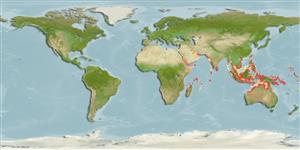Klassifizierung / Names
Namen | Synonyme | Catalog of Fishes(Gattung, Arten) | ITIS | CoL | WoRMS | Cloffa
Environment: milieu / climate zone / depth range / distribution range
Ökologie
seewasser; brackwasser demersal; amphidrom (Ref. 51243); tiefenbereich 1 - 40 m. Tropical
Indian Ocean: known only from Pakistan, India, and Thailand.
Size / Gewicht / Alter
Maturity: Lm ? range ? - ? cm
Max length : 10.8 cm TL Männchen/unbestimmt; (Ref. 122105); common length : 8.0 cm TL Männchen/unbestimmt; (Ref. 3424)
Rückenflossenstacheln (insgesamt): 8; Rückenflossenweichstrahlen (insgesamt): 16; Afterflossenstacheln 3; Afterflossenweichstrahlen: 14. This species is distinguished by having the following set of characters: fully scaled breast; naked cheek; anteroventral profile of lower jaw is almost straight; a distinct, jet-black blotch distally on the spinous dorsal fin (Ref. 74926).
Found on shallow waters near the bottom. Young enter brackish waters (Ref. 4833). Feeds mainly on small crustaceans, foraminiferans and nematodes. Sold fresh and dried salted in markets, also used for fishmeal.
Life cycle and mating behavior
Geschlechtsreife | Fortpflanzung | Ablaichen | Eier | Fecundity | Larven
Kimura, S., R. Kimura and K. Ikejima, 2008. Revision of the genus Nuchequula with descriptions of three new species (Perciformes: Leiognathidae). Ichthyol. Res. 55:22-42. (Ref. 74926)
IUCN Rote Liste Status (Ref. 130435)
Bedrohung für Menschen
Harmless
Nutzung durch Menschen
Fischereien: kommerziell
Mehr Information
NamenSynonymeMetabolismusRäuberÖkotoxikologieFortpflanzungGeschlechtsreifeAblaichenSpawning aggregationFecundityEierEientwicklung
ReferenzenAquakulturAquakultur ProfilZuchtlinienGenetikElectrophoresesVererbbarkeitKrankheitenVerarbeitungNutrientsMass conversion
PartnerBilderStamps, Coins Misc.LauteCiguateraGeschwindigkeitSchwimmstilKiemenoberflächeOtolithsGehirngrößeSehfähigkeit
Tools
Zusatzinformationen
Download XML
Internet Quellen
Estimates based on models
Preferred temperature (Ref.
123201): 27.2 - 29.1, mean 28.5 °C (based on 844 cells).
Phylogenetic diversity index (Ref.
82804): PD
50 = 0.5078 [Uniqueness, from 0.5 = low to 2.0 = high].
Bayesian length-weight: a=0.01175 (0.00681 - 0.02028), b=3.08 (2.93 - 3.23), in cm total length, based on LWR estimates for this species & (Sub)family-body (Ref.
93245).
Trophic level (Ref.
69278): 2.9 ±0.29 se; based on food items.
Widerstandsfähigkeit (Ref.
120179): hoch, Verdopplung der Population dauert weniger als 15 Monate. (K=1.25-1.16).
Fishing Vulnerability (Ref.
59153): Low vulnerability (11 of 100).
